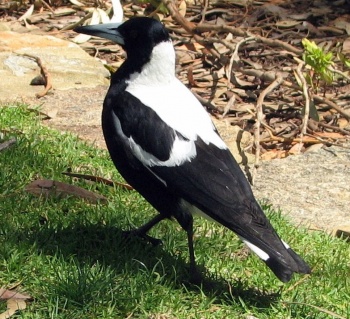Alternative names: Australasian Magpie, Piping Shrike (in South Australia), White-backed Magpie, Black-backed Magpie

Photo © by Tom Tarrant
Samsonvale, SE Queensland, Australia, 03 May 2005
- Gymnorhina tibicen
Identification

Photo © by Mike Jarvis
Perth, Western Australia, Australia, 27 October 2007
37–43 cm (14½-17 in). A large, black-and-white passerine with a long, heavy bill.
Nominate subspecies:
- Plumage mostly glossy black with bright white nape and back of head and rump
- White uppertail with black band at tip
- White vent and undertail-coverts
- White shoulder patch formed by secondary coverts
- Smaller white patch at leading edge of folded wing formed by primary coverts
- Red-brown eye
- Long, heavy bill, slightly hooked at tip, bluish-white with black tip (older birds with more white)
- Long, black legs
Females are similar to males but the white on the head merges to light grey on collar and rump. Juveniles are similar to females but have a loose and fluffy plumage. They are mottled blackish-brown with buff or greyish-brown barring.
The subspecies differs in size and amount of white on the back.
Comparison picture of G. t. hypoleuca and G. t. tibicen
Distribution
Found in Australia (including Tasmania) and southern New Guinea. Introduced in New Zealand and Fiji. Common and widespread.
Taxonomy
Nine or ten subspecies are recognized for this species. Australian Magpie is not a close relative of Magpies and Jays from other parts of the world. It belongs to the Artamidae family and is most closely related to the Butcherbirds. It has also been placed in the genus Cracticus as Cracticus tibicen.
Subspecies
There are 9 subspecies[1]:
- G. t. papuana:
- South-eastern New Guinea (Trans-Fly lowlands)
- Male with white back (sometimes black on mantle), female black-backed
- G. t. eylandtensis:
- Interior of Kimberley and Arnhem Land to north-western Queensland
- Small, with long slender bill, basic pattern like nominate but black band across back of male much narrower and more white on back
- G. t. terraereginae:
- Southern Cape York Peninsula to northern Victoria and eastern South Australia
- Almost identical to nominate but smaller, with shorter wings and a relatively longer bill
- G. t. tibicen:
- South-eastern Australia (south-eastern Queensland to Bega, New South Wales)
- G. t. tyrannica:
- Southern Victoria and adjacent southeast South Australia
- Very large with relatively short bill, whole back white, black tail tip very broad, black thighs
- G. t. hypoleuca:
- Eastern Tasmania, King and Flinders Islands (Bass Strait)
- Similar to tyrannica but smaller, shorter wing and tail, narrower tailband
- G. t. telonocua:
- Southern South Australia to southern Eyre and Yorke Peninsulas
- Similar to tyrannica but smaller and black tip to tail narrower
- G. t. dorsalis: Photo
- South-west Western Australia
- Similar to tyrannica with whtie back but smaller and with short black tip on tail
- G. t. longirostris:
- Central Western Australia (Pilbara region north to King Sound)
- Similar to nominate but with a longer, more slender bill and white feathers on thighs
A 10th subspecies leuconota (White-backed Magpie) is usually considered invalid.[2]
Habitat
Almost everywhere there are trees and open areas of bare soft ground or grass; orchards, playing fields, suburban areas.
Behaviour
Actions
Aggressive. May attack people during nesting season.
Diet
Feeds on invertebrates, mainly terrestrial insects. Takes also small vertebrates (like frogs, lizards, birds or small mammals) and carrion. Feeds mainly on the ground, foraging in groups which spread out over a quite large area.

Photo © by aussietrev
Queensland, Australia, 27 September 2008
Breeding
Breeding recorded from June to March in Australia. Timing varies with location and season. A co-operative breeder with immatures or other adults helping but breeding system varies geographically. The female builds a bowl-shaped nest from sticks, lined with grass and bark. It's placed 2 - 20m above the ground in a tree, mainly in eucalypt.Two to five light blue or greenish eggs are laid and incubated for 20 days.
Vocalisations
One of the finest songbirds of Australia. Different songs vary with locality and subspecies.
Movements
Sedentary, locally nomadic.
References
- Clements, J. F., T. S. Schulenberg, M. J. Iliff, S. M. Billerman, T. A. Fredericks, B. L. Sullivan, and C. L. Wood. 2019. The eBird/Clements Checklist of Birds of the World: v2019. Downloaded from http://www.birds.cornell.edu/clementschecklist/download/
- Del Hoyo, J, A Elliott, and D Christie, eds. 2009. Handbook of the Birds of the World. Volume 14: Bush-shrikes to Old World Sparrows. Barcelona: Lynx Edicions. ISBN 978-8496553507
- Christidis, L. and W.E. Boles. (2008) Systematics and Taxonomy of Australian Birds. CSIRO Publishing, Melbourne.
- Angus, D.J. 2013 [updated 2017]. Australian magpie. In Miskelly, C. M. (ed.) New Zealand Birds Online.
- Higgins, P.J .; Peter, J.M. & Cowling, S.J. (editors) 2006. Handbook of Australian, New Zealand & Antarctic Birds. Volume 7, Boatbill to starlings; Part 7 A, Boatbill to larks. Melbourne, Oxford University Press.
- Avibase
- BirdForum Member Observations
Recommended Citation
- BirdForum Opus contributors. (2025) Australian Magpie. In: BirdForum, the forum for wild birds and birding. Retrieved 29 April 2025 from https://www.birdforum.net/opus/Australian_Magpie
External Links
GSearch checked for 2020 platform.1





